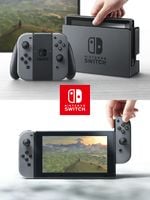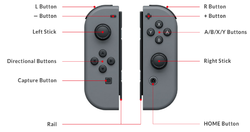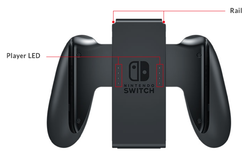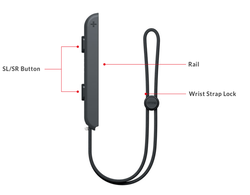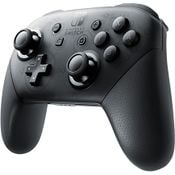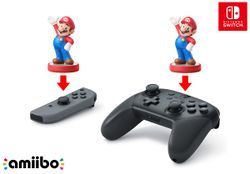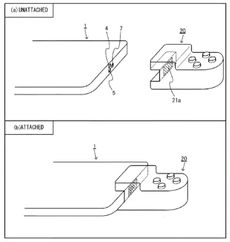Nintendo Switch
Template:Justreleased Template:System-Infobox Template:LLQuote
The Nintendo Switch (codenamed the NX in development)[1] is a hybrid video game console released by Nintendo, and its seventh major home game console. Despite this classification, Nintendo markets the system mostly as a home console that can be played on the go, rather than a dedicated portable handheld system.[2] It was officially announced on October 20, 2016,[3] and was released simultaneously on March 3, 2017 in Japan, the US, Canada, Europe, Hong Kong, and other territories.[4] It costs US $299.99 in America, and JP ¥29,980 in Japan.[4] A Nintendo Switch presentation containing more information about the system was live-streamed from January 12, 2017 at 11:00 PM to January 13, 2017 at 12:05 AM (EST).[5][4] The Nintendo Switch had a hands-on event on six separate Sundays in six different cities across America prior to its release date.[4][6] along with Tokyo Big Sight, Japan.[4] Pre-order retail reservations started on January 21, 2017 in Japan.[4] As of January 12, 2017, 50 companies have collaborated with Nintendo and 80 games are currently in development for the Nintendo Switch.[4]
Features
The Nintendo Switch is an LCD tablet-like console that is designed to be a hybrid between home and handheld systems, though it is primarily referred to as a home console. The Switch can be played in three different styles; TV Mode, Tabletop Mode, and Handheld Mode.[4] In "TV Mode", the system is plugged into a "Nintendo Switch Dock".[7] With the system docked, gameplay footage is displayed on the TV screen. With the console detached, the footage is displayed on the console's screen. When using "Tabletop Mode", the console uses a built-in kickstand to prop the system up. When in "Handheld Mode", the two "Joy-Con" controller pods are attached to the sides of the console, giving it a similar design to the Wii U's GamePad. The Joy-Con can also be removed and used either as separate controllers, similar to small NES and SNES controllers, used as one controller together, or optionally docked into the "Joy-Con Grip"[7] to give a more traditional experience.
The Nintendo Switch console uses "Game Card" cartridges, similar to the Nintendo DS line. The Nintendo Switch Dock also has two USB 2.0 ports,[8] an HDMI output,[4] an AC adapter port, and a TV output LED light.[8] The Nintendo Switch has built in Wi-Fi,[4] Bluetooth 4.1 connectivity,[9] a multi-touch capacitive touchscreen of 6.2-inch diagonally,[4] a resolution of 1920 x 1080p on TV Mode and 1280 x 720p on Tabletop or Handheld mode,[9] a USB Type-C connector,[4] internal memory of 32 GB,[9] a microSD slot (upgradable with microSDHC/SDXC cards),[9] a 3.5mm headphone jack, a brightness sensor, two speakers in the bottom, and a battery life ranging anywhere between 2.5-6.5 hours.[4][9] For example, battery life during The Legend of Zelda: Breath of the Wild gameplay is 3 hours.[8]
Players can also link up to 8 multiple consoles to play against each other via local multiplayer.[4] Each Joy-Con can be used for 2 player co-op, dubbed by Nintendo as "sharing the joy".[4]
Peripherals
Joy-Con
The two Joy-Con have an accelerometer and gyro sensor.[4] The Joy-Con (R) has an IR motion camera that can sense and measure the real-time shape, motion, and distance of objects.[4] Two SL and SR shoulder buttons are on each Joy-Con.[4] The Joy-Con can be slid into the Joy-Con Grip on the controllers' rails.[4] The Joy-Con launched with two color sets: the standard gray and neon blue and neon red.[4] Much like the Wii Remote, each Joy-Con has gray wrist straps with slide locks,[4] with other colors sold separately.[4] An HD rumble feature for high definition haptic feedback is included in the Joy-Con, which can convey realistic effects. For example, shaking the Joy-Con can give the illusion of ice cubes being shaken within a glass cup.[4] Both Joy-Con have Bluetooth 3.0 connectivity.[10] The Joy-Con have a battery life of up to 20 hours and a charging time of 3.5 hours.[10] The Joy-Con (L) has a capture button that can take a screenshot of gameplay, which can be saved onto the system's Album, and can later be edited and uploaded to social media. It has also been discussed that an update in the near future will add the capacity to record real-time gameplay, and allow that to be also uploaded to social media.[4] Two games are currently set to release that utilize the Joy-Con HD rumble and motion control features, such as a minigame-based game called 1-2 Switch which was released as a launch title and a wrestling game called ARMS in Spring 2017.[4]
Buttons




- SL
- SR
- Release buttons
- Sync buttons
- Volume buttons (- and +)
- Directional buttons
- Capture button
- Left analog stick
- Left analog stick button
- Right analog stick
- Right analog stick button
(Home)
- Power
Nintendo Switch Pro Controller
A traditional controller, simply called the Nintendo Switch Pro Controller,[7] also has a D-pad, replacing one set of the directional buttons on the Joy-Con (L). The Pro Controller features the same set-up as the Nintendo GameCube Controller, with the second analog stick set below the face buttons. The Nintendo Switch Pro Controller has a battery life of up to 40 hours and charging time of 6 hours,[11] includes an NFC sensor for scanning and writing amiibo figures, and is sold separately.[4]
amiibo
- Main article: amiibo
The Nintendo Switch has amiibo support.[12] The Joy-Con (R) and Nintendo Switch Pro Controller both have an NFC sensor for scanning and writing amiibo figures.[4][13]
Software
The Nintendo Switch is able to synchronize with smartphones via an application; this allows for online capability to invite friends to play online, set play appointments, and voice chat with friends on online matches.[4] The Nintendo Switch does not have region locking, similar to Nintendo handhelds prior to the Nintendo DSi.[4] A Nintendo Account is necessary to access any online features, with a free trial period for its online service at launch and will later start charging JP ¥2,000-¥3,000 in Japan and US $17.50-$26.50 in America annually starting Fall 2017.[4][14][15] Software for Nintendo Switch is available to purchase at retail and/or Nintendo eShop, similarly to the Wii U and systems in the Nintendo 3DS family before it. The Nintendo Switch is the first Nintendo home console since the Nintendo 64 to have retail software stored on cartridges rather than discs.
Nintendo Switch Parental Controls
The Nintendo Switch also uses optional parental controls, being controlled from a smartphone via an application named "Nintendo Switch Parental Controls", in order to control and monitor a minor's playing time, as well as restricting certain features of the Nintendo Switch. Nintendo has released a video featuring Bowser and Bowser Jr. detailing the functions of the application, with the former monitoring the latter's playing of Mario Kart 8 Deluxe. Boos also appear in the video and Bowser is shown to have a picture of Princess Peach as his phone wallpaper.[16][17]
Nintendo eShop
- Main article: Nintendo eShop
The Nintendo eShop returns, during a small footage depicting the Nintendo Switch's system menu, which is available after a system update.[4][18]
Nintendo Switch HOME Menu

At the top of the Nintendo Switch's system menu, referred to as the HOME Menu,[19] there are profile icon(s), a time display, a Wi-Fi/airplane mode status display, and a battery display. The middle portion includes grids for displaying games' icons, and the bottom has icons for applets including News, Nintendo eShop, Album, Controllers, System Settings, and Sleep Mode, along with a controller display in the lower left.[4]
Development
The Nintendo Switch was originally codenamed the "NX" during development, which wasn't believed to have meant anything in particular.[20] The development of the NX was first mentioned by Satoru Iwata in March 2015 during Nintendo and DeNA's Business and Capital Alliance Announcement, where it was discussed how Nintendo was aiming to "construct a bridge between smart devices and dedicated video game hardware".[1] Later that year, Nintendo president Tatsumi Kimishima elaborated by saying that the NX wasn't going to be another version of the Wii or Wii U platforms, rather "something unique and different".[20]
In 2013, Nintendo chose to merge the handheld and home console development teams into a single Research & Development division,[21] due to the emerging possibility of integrating the software used by both platforms. Satoru Iwata said that it was important to "take advantage" of the established architecture of the Wii U while developing a future system, because of the ability to use common ways to program a handheld display and a full-size television display. At the time, Iwata stated that Nintendo was aiming to change the situation of developing separate versions of games for both handheld and console versions. He expressed interest in developing new hardware using the common programming of Android software, which would help alleviate the time taken to port the same game between separate handheld and home console releases.[21]
Yoshiaki Koizumi, the general producer of the Nintendo Switch console, made sure that the hardware development team included experience from "various different sections and disciplines", including both handheld and home console design.[22] He wanted to make sure sure that there was a high potential of "mixing and matching" those different areas of experience, to reach a single product. Many different hardware designs were proposed and considered, including a patented elliptical touch-screen controller capable of 3D display,[23][22] as well as a controller which uses a camera to sense the player's hand actions.[22] The NX's vision was to appeal to the on-the-go lifestyle of today's consumers, and adapt to their needs. This lead to the concept of "switching" between a home console and a handheld.
Shinya Takahashi, the general manager of the Entertainment Planning & Development Division at Nintendo, described how the early brainstorming stages focused on the essential functions of a portable home console.[22] The team also looked back at the accessibility and popularity of the Wii when developing the Switch, while still retaining features from other past Nintendo consoles, such as the handheld screen of the Wii U. Early on, it was also considered important for the system to come with two controllers that can be attached and brought on the go for two players to easily play together (in a similar way to how the Famicom docked two controllers on the system), although still providing a "full and satisfying single-player experience". Reggie Fils-Aime stressed the concept of "constant engagement" during Nintendo Switch planning, and appeal to an "anywhere, anytime, any way" approach.[24] The use of color was recognized to have been emphasized by Nintendo's systems in the past, notably with the Nintendo GameCube and Super Nintendo's multi-colored buttons. This inspired the use of red and blue Joy-Con for the Nintendo Switch, whereas the alternative grey design was aimed to appeal more to a "core gamer who is looking for something more sleek".[22]
A notable challenge during development was "packing" all of the required technology and features into the Joy-Con's desired weight and size, such as the IR Motion Camera, while still focusing on "communicating" the value of that technology through the software.[22] The HD Rumble, described by Yoshiaki Koizumi as a form of "virtual reality", required a lot of collaboration and trials between the hardware and software teams in order to utilize it within game design.
In 2015, Satoru Iwata spoke of the need for region locking wasn't entirely due to consumer actions, but of the seller in global vendor licenses and different circumstances between countries. Iwata acknowledged that there were advantages for both the consumers and Nintendo in lifting region restrictions, and if future hardware were to use region-free games, then such problems would need to be pre-determined and subsequently solved.[25] On January 12, 2017, Nintendo announced during a livestream presentation that the Nintendo Switch's games will be region-free.[26]
The name "Nintendo Switch" was decided due to the ability to easily switch from a television screen to a handheld screen, as well as being akin to flipping a switch to "change the way people experience entertainment in their daily lives."[27]
Physical and digital games
Gallery
System
Software
- SMO Logo - NA.png
PAX South Event
Trivia
- The Nintendo Switch is the first Nintendo home console to be released before a Nintendo handheld of the same generation since the Nintendo 64.
External links
References
- ^ a b Iwata, Satoru (March 17, 2015) Business and Capital Alliance Announcement. Nintendo. Retrieved January 31, 2016
"[...] let me confirm that Nintendo is currently developing a dedicated game platform with a brand-new concept under the development codename 'NX'." - ^ Reggie calls the Nintendo NX a home console. Wii U Daily (June 19, 2015). Retrieved June 16, 2016.
- ^ Nintendo. (October 20, 2016). First Look at Nintendo Switch. YouTube. Retrieved October 20, 2016.
- ^ a b c d e f g h i j k l m n o p q r s t u v w x y z aa ab ac ad ae af Nintendo (January 12, 2017) Nintendo Switch Presentation 2017 YouTube. Retrieved February 11, 2017.
- ^ Nintendo of America. (October 26, 2016) https://twitter.com/NintendoAmerica/status/791455799302246400. Twitter. Retrieved November 11, 2016.
- ^ http://www.nintendo.com/switch/events/
- ^ a b c http://www.nintendo.com/whatsnew/detail/first-look-at-nintendos-new-home-gaming-system
- ^ a b c Nintendo. Nintendo Switch Features Nintendo. Retrieved February 11, 2017.
- ^ a b c d e Nintendo. Nintendo Switch Specs (Japanese). Nintendo. Retrieved February 11, 2017.
- ^ a b Nintendo. Nintendo Switch Joy-Con Specs (Japanese) Nintendo. Retrieved February 11, 2017.
- ^ https://www.nintendo.co.jp/hardware/switch/accessories/index.html
- ^ http://nintendoeverything.com/nintendo-confirms-amiibo-support-for-switch-says-dock-is-for-tv-output-and-charging
- ^ https://www.facebook.com/amiiboUK/photos/a.336211199898791.1073741828.336093763243868/611534995699742/?type=3&theater
- ^ http://www.nintendo.com/switch/online-service/
- ^ https://twitter.com/serkantoto/status/826841955111890944
- ^ https://www.youtube.com/watch?v=03bAayBtcb0
- ^ http://www.nintendo.com/switch/family-fun/
- ^ https://www.youtube.com/watch?v=t5lK0yzP6_4&t=88
- ^ https://www.nintendo.co.uk/Nintendo-Switch/Specifications/Specifications-1176277.html
- ^ a b Peckham, Matt (December 3, 2015) 14 Things Nintendo President Tatsumi Kimishima Told Us. Time. Retrieved March 3, 2017.
- ^ a b Iwata, Satoru Third Quarter Financial Results Briefing Ending March 2014: Question 5. Nintendo. Retrieved March 3, 2017.
- ^ a b c d e f IGN. (February 28, 2017) How Nintendo Made the Switch. YouTube. Retrieved March 3, 2017.
- ^ Byford, Sam (December 11, 2015) Wild Nintendo patent filing shows game controller made out of a screen. The Verge. Retrieved March 3, 2017.
- ^ Brian (March 1, 2017) Reggie on Switch. Nintendo Everything. Retrieved March 3, 2017.
- ^ Iwata, Satoru Semi-Annual Financial Results Briefing Ending March 2015. Nintendo. Retrieved March 3, 2017.
- ^ McWhertor, Michael (January 12, 2017) Nintendo Switch will be region-free. Polygon. Retrieved March 3, 2017.
- ^ Brian (December 6, 2016) Nintendo on Switch’s name. Nintendo Everything. Retrieved March 3, 2017.
